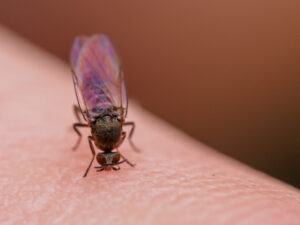
There seems to be a close relationship between the quality of trout fishing and the number of blood-sucking insects. The more scenic the river, the greater the swarms which zone in on bare skin.
The New Zealand sandfly might just be the countries best kept secret. They live in large numbers in nearly all prime trout fishing locations. Sandflies love the taste of tourists, but their favourite meal must be the unsuspecting fly fishermen. We slowly walk along their riverside homes, stopping frequently. We even crouch down without moving for extended periods of time. Sandflies must dream about us. Fortunately, with a little preparation and forward planning, sandflies are not a problem. It is very easy to protect one’s skin to avoid getting eaten alive.
Cover as much skin as possible.
Sandflies love bare skin. So wearing long sleeves and pants immediately reduces the amount of skin they can access. I have never been bitten by a Sandfly through fabric. Wearing long sleeves also provides additional protection against the harsh New Zealand sun.
For these reasons, over the warmer months when trout fishing, I basically live in quick drying nylon pants and shirts. I mostly wear light color Columbia Silver Ridge clothing. I have been buying the brand for over 20 years and have never been disappointed. It dries quickly; the quality is as good as any, and it is affordably priced. The Columbia pants fit my tall build well, while the Silver ridge shirts have good size pockets. They also come in a range of natural colors ideal for trout fishing. I prefer them over the Simm clothing range.
In over twenty years of fishing, I have never had a sandfly bite my face or neck. When they swarm around my face, they certainly get annoying (although the Scottish midges are a hundred times worse). I find simply wearing a hat and sunglasses is enough to keep them out of my vision.
Insect repellent provides great protection against sandflies
Unless you are one of the lucky few which Sandflies ignore, carrying a small bottle of insect repellent is essential. Otherwise, expect sandflies to bite any exposed skin. Applying repellent on the back of hand, wrists and ankles is normally enough to keep sandflies at bay.
Regarding brands. I have found most repellents work well; I do not have a strong preference. A low percentage DEET gel works well. It does a good job at keeping any mosquitoes away when sitting around camp late at night.
When applying repellent, I try my best to avoid getting it on my flies, lines and even fingertips. Many believe that the smell of repellent can put trout off striking. For that reason, I apply insect repellent with the back of my hand.
Just tough it out
Sandflies do not hurt much when they bite, if unlucky about half an hour later an itchy red mark would start to swell. If you itch it, it gets worse. If you ignore it, then eventually it goes away. On more than one occasion, I forgot or run out of repellent. So I had to tough it out. A few bites is not worth ruining a day’s fishing. Getting eaten alive while waiting silently for a cruising trout to return is a bit like torture but the thrill of hooking up is enough to forget.
Sandflies, also fly slowly. If you walk along at a steady pace, they quickly fall behind. It is only once you stop that a new swarm gathers. Sandflies mostly rest on vegetation or on the cracks between rocks. So wading out into the current greatly reduces the size of the swarm. They can be persistent I had one follow me over offshore while kayaking.
Avoid the backcountry
Sandflies need clean freshwater and natural vegetation to survive, resulting in them being common in the most scenic locations. The picturesque rivers and lakes we love to fish are ideal habitat for sandflies.
New Zealand still offers some excellent trout fishing much closer to town. In the rivers and streams which flow through our farmland. When fishing these lower rivers, it is very unlikely to encounter large numbers of sandflies. The lower sections of rivers on the East Coast are almost entirely free of sandflies.
